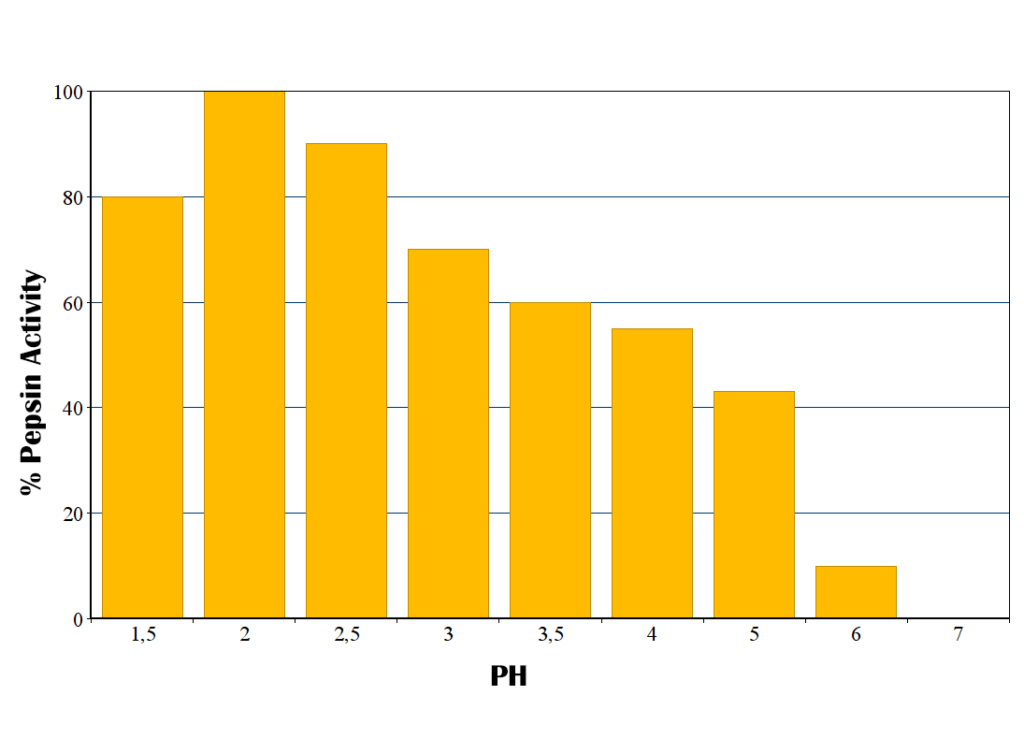Reflux is typically thought of as an acidic liquid, which causes symptoms such as heartburn by irritating the esophagus.
Reflux can, however, also be an aerosol, essentially a fine mist. You could stretch it a bit and call it gaseous. This gaseous reflux can rise further up until it reaches the throat and airways, and is known as silent reflux, or LPR.
Gaseous reflux is also acidic, just like liquid reflux. However, while this acid can irritate the mucous membranes, acid is not the main problem when it comes to silent reflux. The actual damage is caused by pepsin, which is an enzyme produced in the stomach. Acid merely has a helping role in this process.
What is Pepsin?
Pepsin is an enzyme produced in the stomach that is essential for the digestive process. Its job is to break down proteins.[1]
In silent reflux, pepsin is carried along with the gaseous reflux, thereby reaching the throat and airways. Because pepsin usually resides in the stomach, it is active at a low (acidic) pH. Let’s have a closer look at how pH influences pepsin’s activity and how pepsin causes damage to mucous membranes.
pH-Dependent Activity of Pepsin
Pepsin is most active at a low pH of up to 2.5. From that point, its activity slowly decreases with rising pH. At pH 4, the activity is down to less than 60%, and at pH 6, it’s around 10%. At a pH of 6.5, pepsin becomes inactive.[2]

Permanent Deactivation of Pepsin Through High pH
There is only one way of permanently deactivating pepsin: with a pH higher than 8.[3]
Our airways usually don’t have a pH higher than 8, though; and besides, almost all foods and drinks have either acidic or neutral pH (7 and below).
One possible way of raising the pH in the throat and airways is by drinking alkaline water, which is simply water with a high pH.
Alkaline water can be prepared with baking soda or with the help of special water filters. However, not all alkaline water is suitable, because a high pH is necessary for the water to work efficiently.
Pepsin is Usually Inactive Outside the Stomach
In silent reflux, pepsin is carried along with the gaseous reflux and thereby reaches the throat and airways. Outside the stomach, the pH is so high that pepsin is usually inactive. This is also true for the areas where LPR causes damage, such as the throat and airways. The pH of our throat and airways is typically above 6.5. The larynx (voice box), for instance, has a pH of about 6.8.[4]
Reactivation of Pepsin Through Acid
While pepsin is expected to be inactive outside the stomach, a low pH or an acidic environment can reactivate it.[5]
There are two possible means by which the pH in throat and airways can be lowered:
- acid reflux itself
- acidic foods and drinks.
Which Foods Are Acidic?
Acidity is normally defined by pH. To minimize the reactivation of pepsin, people with silent reflux should avoid anything with a pH of lower than 5.
Unfortunately, there are some misconceptions about the acidity of foods. Foods may form acids or bases after digestion, and hence are sometimes referred to as alkaline or acidic foods, particularly in more wellness-oriented magazines and online media. This, however, has nothing to do with the actual pH of the food before digestion and when passing down the throat. For instance, lemons have a low pH but are regarded as being alkaline.
This article provides more information about this confusing topic and will explain what pH values matter for reflux.
How Pepsin Damages the Mucous Membranes
Once pepsin gets activated outside the stomach, it can cause a lot of damage. Pepsin is specialized for breaking down proteins. The problem is that we primarily consist of proteins. While the lining of the stomach has defense mechanisms against pepsin, the mucous membranes of the throat are unprotected. As soon as activated pepsin reaches the cells of the mucous membranes, it starts to attack them by breaking down their proteins. This causes a lot of damage with consequent inflammation.
Reactivation of Pepsin in the Deeper Mucous Membrane Layers
Besides being reactivated through reflux acid and acidic foods, there might be a further mechanism by which pepsin regains its activity.
Pepsin is taken up by the cells of the mucous membranes and thereby reaches deeper layers that have a lower pH. From there, it causes damage from the inside.[6]
This is probably the reason why reflux therapy can take a long time to be effective: Even if acid is minimized through the avoidance of acidic foods, pepsin is still taken up by the mucous membranes and reactivated.
For this reason, reflux treatment always has to address both factors: the reflux itself and the activation of pepsin.
Successful LPR treatment Focuses on Pepsin.
Because pepsin is primarily responsible for the damage in silent reflux, a successful treatment strategy for LPR has to
- minimize the reflux to prevent
pepsin from reaching the throat and the airways; - avoid the reactivation of pepsin as
far as possible.
Dietary changes address both factors, which is the reason why they are so efficient at eliminating silent reflux symptoms.[7] In my online course on the treatment of LPR, you learn precisely which dietary measures are the most promising.
References
[1] Fruton JS. A history of pepsin and related enzymes. Q Rev Biol. 2002;77(2):127–47.
[2] Johnston N, Dettmar PW, Bishwokarma B, Lively MO, Koufman JA. Activity/stability of human pepsin: implications for reflux attributed laryngeal disease. Laryngoscope. 2007;117(6):1036–9.
[3] Koufman JA, Johnston N. Potential benefits of pH 8.8 alkaline drinking water as an adjunct in the treatment of reflux disease. Ann Otol Rhinol Laryngol. 2012;121(7):431–4.
[4] Campagnolo AM, Priston J, Thoen RH, Medeiros T, Assunção AR. Laryngopharyngeal reflux: diagnosis, treatment, and latest research. Int Arch Otorhinolaryngol. 2014;18(2):184–191.
[5] Koufman JA. The otolaryngologic manifestations of gastroesophageal reflux disease (GERD): a clinical investigation of 225 patients using ambulatory 24-hour pH monitoring and an experimental investigation of the role of acid and pepsin in the development of laryngeal injury. Laryngoscope. 1991;101(4 Pt 2 Suppl 53):1–78.
[6] Johnston N, Wells CW, Blumin JH, Toohill RJ, Merati AL. Receptor-mediated uptake of pepsin by laryngeal epithelial cells. Ann Otol Rhinol Laryngol. 2007;116(12):934–8.
[7] Koufman JA. Low-acid diet for recalcitrant laryngopharyngeal reflux: therapeutic benefits and their implications. Ann Otol Rhinol Laryngol. 2011;120(5):281–7.

